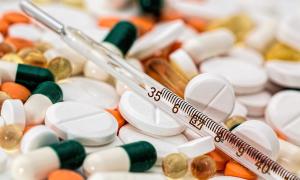Of 72 antivirals tested in the laboratory, plitidepsin proves to be the most effective in preventing SARS-CoV-2 replication

IrsiCaixa and CReSA, as part of the consortium formed by these two institutions, together with the BSC, have tested 72 antivirals with the aim of assessing their ability to prevent infection by SARS-CoV-2. Plitidepsin, commercialised as Aplidin, has shown the highest efficacy
The need to identify effective treatments for COVID-19 is key to preventing the progression of the disease and its more advanced stages, which can lead to the death of infected people. For this reason, the team from the IrsiCaixa AIDS Research Institute and the Centre for Research in Animal Health (CReSA) as part of the CBIG consortium, which includes IrsiCaixa, IRTA, the Barcelona Supercompunting Center and Grifols, have tested 72 antivirals that were already approved for clinical use, in order to assess their ability to prevent infection by SARS-CoV-2. Of all the compounds tested, plitidepsin, commercialised as Aplidin, has shown the greatest efficacy, followed by cathepsin inhibitors, remdesivir, interferon 2-alpha and gamma and fenofibrate, among other compounds.
Because antiviral treatments tend to be more effective when used in combination, researchers studied the step of the viral cycle at which each of these 72 drugs acts, as well as the possible effective combinations among them. The study has shown that hydroxychloroquine, initially used as a treatment and prophylaxis for COVID-19, is effective in preventing the entry of SARS-CoV-2 through compartments called endosomes, as occurs in kidney cells. In contrast, this drug cannot block SARS-CoV-2 when it enters through binding to the cell's receptor and fusion with its membrane, a process that occurs precisely in the lung.
Plitidepsin, more effective than remdesivir in vitro
The study analysed the ability of 72 antiviral drugs to prevent SARS-CoV-2 infection in cells in the laboratory. "We wanted to evaluate the efficacy of different drugs that are already being used in other diseases in order to find quick and effective solutions against COVID-19," explains Nuria Izquierdo-Useros, principal investigator at IrsiCaixa and leader of the study together with Júlia Vergara-Alert, principal investigator at IRTA-CReSA.
Of all the drugs analysed, the most effective is plitidepsin, which at very low concentrations is able to block virus replication very efficiently. It is followed by cathepsin inhibitors, remdesivir, interferon 2-alpha and gamma and fenofibrate, among others. These results made it possible to propose the organisation of clinical safety studies (clinical phase 2) with plitidepsin, which have now been completed and whose efficacy is now being evaluated in a phase 3 clinical trial.
Attacking the virus from different sides
Antiviral drugs can act at different points in the life cycle of the virus, i.e. they can block at different steps in the process that the virus must follow in order to infect and thus continue to multiply and infect new cells. In order to block the virus from entering cells and prevent the next steps in the infection process, antiviral treatments often combine more than one drug. This is also key to preventing the emergence of viruses that are resistant to a particular type of treatment, as the combination of several drugs slows down the emergence of escape variants. This is why the team has evaluated which combinations could be most effective and, although none of them has shown more efficacy than administering the drugs individually, the simple fact of being able to give combined therapies without losing efficacy makes it possible to control the emergence of resistant viruses.
In order to infect, SARS-CoV-2 must bind to a receptor on the membrane enveloping the host cell. From this binding, there are two possible routes of entry; fusing with the cell membrane at the cell surface (Figure 1 A) or entering through endosomes, compartments formed by the cell membrane as it surrounds the virus and engulfs it (Figure 1 B). From here, the two pathways converge into a single process: the release of the virus into the cell, allowing it to replicate, that is, to duplicate its genetic material and produce the proteins needed to form new viral particles.

Figure 1 A, B | Representation of the different points of action of drugs in the SARS-CoV-2 viral cycle. Illustration by Daniel Perez-Zsolt, postdoctoral researcher at IrsiCaixa, adapted from the article https://www.mdpi.com/2077-0375/11/1/64
After carrying out the study, it was possible to identify some drugs that prevent the virus from entering cells (Figure 1) and also to prove that the most effective drugs in preventing SARS-CoV-2 infection are those that block virus replication, as in the case of plitidepsin and remdesivir. On the other hand, the researchers have found that drugs that are very effective in some cell types that act by blocking the entry pathway through endosomes, such as hydroxychloroquine does in kidney cells, are much less effective in lung cells that have an active entry pathway in the membrane. "The reason drugs like hydroxychloroquine have been shown to be less effective is that SARS-CoV-2 does not enter lung cells through endosomes", says Jordi Rodon Aldrufeu, first author of the study and CReSA researcher. "Blocking this pathway to prevent infection in the lungs is not useful. However, it does make sense to use it in other SARS-CoV-2 target cells outside the lung, and that is why the use of hydroxychloroquine cannot be ruled out, but always in combination with other drugs that act at the pulmonary level", concludes Rodon.